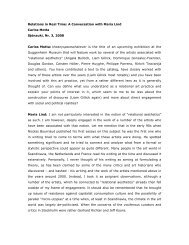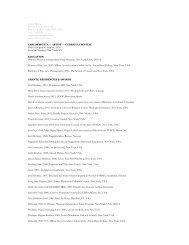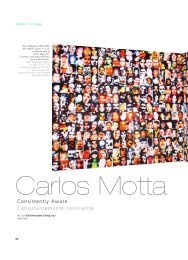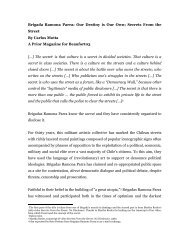here - Carlos Motta
here - Carlos Motta
here - Carlos Motta
You also want an ePaper? Increase the reach of your titles
YUMPU automatically turns print PDFs into web optimized ePapers that Google loves.
CARLOS MOTTA—ART PORTFOLIO
BIOGRAPHY<strong>Carlos</strong> <strong>Motta</strong>’s work has been presented internationally in venues such as Tate Modern,London; New Museum, Guggenheim Museum and MoMA/PS1 Contemporary Art Center, New York; Institute ofContemporary Art, Philadelphia; Museo de Arte del Banco de la República, Bogotá; Museu Serralves, Porto; Museud’Art Contemporani de Barcelona; National Museum of Contemporary Art, Athens; Castello di Rivoli, Turin; CCSBard Hessel Museum of Art, Annandale-on-Hudson; San Francisco Art Institute; Hebbel am Ufer, Berlin; Wittede With, Rotterdam; Sala de Arte Público Siqueiros, Mexico City; and many other public, private and independentspaces throughout the world.A survey exhibition of <strong>Carlos</strong> <strong>Motta</strong>’s work was presented by Röda Sten Konsthall, Gothenburg in 2015. <strong>Motta</strong> willalso have solo exhibitions at Mor Charpentier Galerie, Paris and PinchukArtCentre, Kiev in 2015 as well as at theHordaland Kunstsenter, Bergen; Museo de Arte Latinoamericano de Buenos Aires (MALBA); and Mercer Union, Torontoin 2016.<strong>Motta</strong> won the Main Prize—Future Generation Art Prize of the PinchukArtCentre in Kiev (2014), was named a GuggenheimFoundation Fellow in 2008 and received grants from Art Matters in 2008, NYSCA in 2010 and the CreativeCapital Foundation in 2012.www.carlosmotta.comwww.wewhofeeldifferently.infowww.wewhofeeldifferently.infowww.la-buena-vida.infomottacarlos@yahoo.com — +1.917.553.5546
TO WATCH A 10 MINUTE TRAILER OF VIDEOS—https://vimeo.com/130355117
Deseos / تابغر (2015) (FILM)TO WATCH THE FILM:https://vimeo.com/127254583Password: deseosThe film Deseos / تابغر (Desires) exposes the ways in which medicine, law, religion, and cultural tradition shapeddominant discourses of the gendered and sexual body through the narration of two parallel stories. The first is thatof Martina, who lived in Colombia during the late colonial period of the early 19th century. The second is the fictionalizedlife of Nour, who lived in Beirut during the late Ottoman Empire. Part documentary and part fiction, thefilm presents an imaginary correspondence between these women. Separated by geography, culture, and religionthey both faced the consequences of defying sex and gender norms.The colonial court prosecuted Martina in 1803 for being a “hermaphrodite” after being accused by her female loverof having an “unnatural” body. Martina was tried in a court of law and ultimately set free after medical doctorsappointed by the court were unable to find evidence of her lover’s accusation. This story is documented in the 1803legal case found in the Archivo General de la Nación in Bogotá, Colombia.Meanwhile in Beirut, Nour was married to her lover’s brother after Nour’s mother found them making love. Despitethe fact that Nour’s story does not occur in a courtroom nor is it found in a legal case, notions of Islamic and lateOttoman laws, cultures, and histories condition her narrative.
Deseos / ,تابغر 32 min. video, color, sound, HD 16:9
NEFANDUS (2013) (INSTALLATION)Nefandus explores the imposition of European epistemological categories onto native cultures during the Spanishand Portuguese Conquest of the Americas. This projects includes photographs, sculptures and videos, all of whichaddress subjects that were deemed “exotic,” “wild,” or “native”.The project’s central axis is Nefandus Trilogy (2013) three narrative videos that investigates pre-Hispanic homoeroticism.While it has been widely documented that the conquistadores used sex as a weapon of domination ofindigenous populations, little is known about the homoerotic indigenous traditions. How did the Christian morality,as taught by the Catholic missions and propagated through war during the Conquest, transform the natives’ relationshipto sex?“Nefandus,” Latin for impious, abominable, or unnamable, was a common word used in Colonial Latin America inreference to sin. A pecado nefando (unspeakable sin) was a transgressive crime of sexual nature, such as sodomy,which was severely judged and punished. The video suggests that constructions of sexuality and the body can’tbe projected onto cultures whose traditions and histories remain unknown and have been mediated by Europeanclassifications.Nefandus asks what would be the consequence of reclaiming historical categories andinscribing them with new meanings – through speculation, research or imagination – in order to gain greater socialfreedom for the present.
Atlas (2013), gold washed silver, miniature figure, magnifying glass and shelf
Nefandus Trilogy, films and objects, installation views at Röda Sten Konsthall, Gothenburg, 2015
Nefandus Trilogy, installation views at Röda Sten Konsthall, Gothenburg, 2015
Towards a Homoerotic Historiography, room size installation for gold washed silver miniature golden figures, a printand a sculpture.
Towards a Homoerotic Historiography, gold washed silver miniature golden figures
TO WATCH THE FILMS:Nefandus, 201313’04”HD 16:9, video, color, soundhttps://vimeo.com/66318757Naufragios (Shipwreck), 201312’31”HD 16:9, video, color, soundhttps://vimeo.com/77791138La visión de los vencidos (The Defeated), 20136’46”HD 16: 9 format video, colour, soundhttps://vimeo.com/77764466
Naufragios, 12’31” HD 16:9, video, color, sound
La visión de los vencidos, 6’46” HD 16:9, video, color, sound
THE DEFEATED (2014) (INSTALLATION)La visión de los vencidos (The Defeated) investigates the imposition of European epistemological categories ontoindigenous cultures during and after the Conquest of the Americas with an emphasis on the construction of “sexuality”and “gender” as identity categories based on Judeo-Christian precepts. The Defeated is an experiment ofspeculation on the ways in which indigenous groups may have lived homoeroticism as part of theirsociability.The works in the exhibition are a collection of drawings and sculptures that represent homoerotic acts —based onindigenous artifacts found throughout the Americas (pottery, jewelry, etc.). These works suggest a reading of thoseobjects beyond their traditional interpretation as ritualistic or spiritual symbols. How did the many different indigenousgroups relate to ideas of pleasure or desire?La visión los vencidos asks: Could we transcend epistemological categories that reproduce forms of exclusionbased on sexual and gender difference? What kind of epistemological tools would one need to decolonize the bodywhen the very tools available to us are colonial tools themselves?
The Defeated (2014), installation views at La Central, Bogotá
Atlas (2013), gold washed silver, miniature figure, magnifying glass and shelf
Towards a Homoerotic Historiography (2013), pencil and watercolor on paper, 9 x 12”
Nefandus, inkjet print, 20 x 30”
Untitled, stone carved penis in vitrine. Object: 25,4 x 8,9 cm – Vitrine: 41,5 x 65,5 x 45 cm
WE WHO FEEL DIFFERENLTY (2012)(INSTALLATION, WEBSITE, BOOK, EVENTS)We Who Feel Differently is a multi-platform project that features Interviews with fifty queer academicians, activists,artists, radicals, researchers, and others in Colombia, Norway, South Korea and the United States about thehistories and development of LGBTIQQ politics in these countries. The interviewees have been active participantsin the cultural, legal, political, and social processes around sexual difference; they frame the debates and discussthe mainstream LGBT Movement’s agenda from queer perspectives.The book (co-edited by <strong>Carlos</strong> <strong>Motta</strong> and Cristina <strong>Motta</strong>) presents five thematic threads drawn from the interviewsand puts forth an assemblage of queer critiques of normative ways of thinking about sexual difference.The Journal is an online publication that presents in depth analyses of LGBTIQQ politics.We Who Feel Differently attempts to reclaim a queer “We” that values difference over sameness, a “We” that resistsassimilation, and a “We” that embraces difference as a critical opportunity to construct a socially just world.TO VIEW WEBSITE: wewhofeeldifferently.info
6-channel video installation, drawings, sculptures, carpet. Installation wiews at New Museum, 2012
6-channel video installation, drawings, sculptures, carpet. Views at New Museum, NY, 2012
GENDER TALENTS (2015) (WEBSITE)Gender Talents is a web-based project that engages movements and discourses for gender self-determinationwithin trans and intersex communities internationally.Gender Talents features an online archive of video portraits of trans and intersex activists who thoughtfully performgender as a personal, social, and political opportunity rather than as a social condemnation. Based on indepthinterviews conducted in Colombia, Guatemala, India and the United States the portraits expose the waysthat activists challenge the bio-cultural ‘foundations’ of society and question gender norms from the perspectiveof sexuality, class, race, ethnicity, and disability.Gender Talents documents the ways in which society conditions and regulates bodies and how gender activistsbuild politics of resistance and action. From Joggapa and trans communities in India, to sex workers in Colombiaand Guatemala, to intersex activists in the United States, these individuals and organisations fight for state recognition,the right to self-determine their identities, self-govern their bodies, access to work, health benefits, andother pressing issues.Gender Talents is also an ongoing platform for physical events that launched in February 2013 with the Electraand Tate Modern commissioned project Gender Talents: A Special Address, a performative symposium held at TateModern’s The Tanks, which used the manifesto as a structure to explore alternatives to the gender binary. Ot<strong>here</strong>vents have included Gender Talents: Sexual and Gender Dissidence and Political Practices from REDMMUTRANS,a large gathering of Guatemalan trans activists and indigenous trans women, convened by the activist organizationRed Multicultural de Mujeres Trans de Guatemala (REDMMUTRANS) and <strong>Carlos</strong> <strong>Motta</strong>, and held during the 19Bienal de Arte Paiz; and Hips Don’t Lie a choreographic intervention on the streets of Frankfurt developed by artistsCamilo Godoy and <strong>Carlos</strong> <strong>Motta</strong> to challenge perceptions of gender performance in public space, presented byKünstlerhaus Mousonturm in 2014.TO VIEW WEBSITE: gendertalents.info
screenshot from gendertalents.info
GENDER TALENTS: A SPECIAL ADDRESS (2013)(EVENT AT TATE MODERN, LONDON)Gender Talents: A Special Address, convened by <strong>Carlos</strong> <strong>Motta</strong>, presents an international group of thinkers,activists, and artists in a symposium that uses the proposition or manifesto as a structuring device and startingpoint for discussion. These ‘special addresses’ will explore models and strategies that transform the ways in whichsociety perversely defines and regulates bodies. The event seeks to ask what is at stake when collapsing, invertingor abandoning the gender binary. Here the relation between self-determination and solidarity in processes ofsystemic change form the foundation of a pragmatic exploration of ways of being ungoverned by normative gender.With: Xabier Arakistain, Esben Esther Pirelli Benestad, Giuseppe Campuzano, J. Jack Halberstam, <strong>Carlos</strong> <strong>Motta</strong>,Beatriz Preciado, Dean Spade, Terre Thaemlitz, Wu Tsang & Safra Project, Del LaGrace Volcano and Campbell X<strong>Carlos</strong> <strong>Motta</strong>’s Gender Talents is an ongoing project, which through concrete, theoretical and abstract routes seeksto depart radically from the binary logic of sexual and gender representation.TO WATCH VIDEO DOCUMENTATION:http://www.tate.org.uk/context-comment/video/charming-revolution-congress-gender-talents
Gender Talents: A Special Address, symposium at TATE Modern’s The Tanks, London February 2013
SHAPE OF FREEDOM (2013) (MURAL AND PUBLICATION)Shape of Freedom is an interdisciplinary project that investigates the political developments of sexual activism inMexico and other Western countries. The work recovers the historiography of the pink triangle and other representationalsymbols to promote sexual difference as a real alternative for individual autonomy and self-determination.While stressing the importance of collective processes for the advancement of the notion of social freedom,the proposal focuses on various milestones to approach the complexities of the Mexican context: a mural, a timelineproduced by the artist and a conversation with local activists, the general public and <strong>Motta</strong>. The chronologywas developed in collaboration with Vargas, a researcher from McGill University in Montreal, Canada. It includesdates, emblems and other significant moments in the history of sexual activism. In this sense, a pink a trianglepainted on the façade of the museum is only the beginning of the Shape of Freedom.During World War II, the symbol was used by the Nazis to identify homosexual prisoners in concentration camps.Later on, American activists in the 1970s appropriated the image as a sign of social empowerment, which representedprogressive ideals such as the abolition of marriage, patriarchy and capitalism –as a movement thatstrived for a society free of sexual exclusion. In the midst of the HIV/AIDS crisis, the emblem was adopted as partof the efforts to fight the epidemic. In the middle of the same decade, the rainbow flag replaced the triangle as a“symbol of freedom,” but it also emerged as a different type of activism that slowly abandoned the desire for a fundamentalsystemic change, while assimilating a heterosexual normativity.
Mural on the façade of the SAPS in Mexico City and newsprint publication, 16.5 x 22”
TIMELINES/CHRONOLOGIES (2005-2014) (PUBLICATIONS)Since 2005 I have produced timelines and chronologies that produced revisions of historical events:Brief History of US Interventions in Latin America Since 1946 (2005)22.5 x 16.5”, black and white newsprintBrief History of Leftist Guerrillas in Latin America (2009)22.5 x 16.5”, black and white newsprintBrief History is composed of two thorough historical timelines: Brief History of U.S. Interventions in Latin AmericaSince 1946 and Brief History of Leftist Guerrillas in Latin America. These works cover the years of the Cold War(1940s-1990s) and expose on the extreme ideological differences that defined that time. On the one hand, theemphatic rejection communism by the U.S. and the actions that were carried through to prevent its spread, and onthe other hand the formation of several dozens of leftists groups that attempted to overthrow the government andto replace it with a Marxist state.A Timeline of Queer Migrations (2011) (with QUEEROCRACY)22.5 x 16.5”, duo tone, black and magenta newsprintTo highlight the issues faced by queer immigrants in the United States, the grassroots organization QUEEROCRACYin collaboration with artist <strong>Carlos</strong> <strong>Motta</strong> staged A New Discovery: Queer Immigration in Perspective, a social intervention-basedperformance held on Columbus Day (October 10), 2011 at Columbus Circle in New York City, w<strong>here</strong>they collectively read excerpts of the A Timeline of Queer Immigration.A Timeline of Queer Migrations brings attention to the way immigrant and queer politics intersect in the publicsp<strong>here</strong> in ways that both confront, challenge and transform the state mechanisms that police borders and bodiesin the United States. This dialogue strives to generate new ideas on how to better make a difference in the lives ofqueer people around the world.
DEUS POBRE: MODERN SERMONS OF COMMUNAL LAMENT (2011)(INSTALLATION)DEUS POBRE: Modern Sermons of Communal Lament is a video installation based on a series of performative interventionsin Catholic churches in Porto, Portugal. Six ordained priests —all of whom share an interest in the theologymovement known as Liberation theology— read excerpts of key sermons and texts delivered by theologiansand priests since the 17th Century.Liberation theology emerged in the 1970s in Latin America —with developments in other parts of the world—w<strong>here</strong> oppression, marginalization and vulnerability have determined the social landscape since the times of theConquest. The movement focuses on the “dialogue between the Christian tradition, social theory, and the insightof the poor into their own situation, leading to action for change.”(1) Liberation theology underlines the politicalpotential of the church’s mission and denounces instances when the church has been complicit with regimes ofimperial and oppressive power.Set in Portugal, DEUS POBRE, which translates as Impoverished God, revisits this particular history by asking contemporarypriests to deliver, during their daily mass or for a public audience, theological-political sermons originallywritten by Bartolomé de las Casas (1542), António Vieira (1653-57), Gustavo Gutiérrez (1971), Óscar Romero(1977-80),and Leonardo Boff (1996). Thus the priests engage with Portugal’s colonial history and the past role ofthe church in missionary evangelization, as well as with its current institutional role in a globalized and sociallyunequal world w<strong>here</strong> the majority of its population lives in abject poverty.TO WATCH VIDEOS: http://carlosmotta.com/project/deus-pobre-modern-sermons-of-communal-lament-2011
Two-sided video projection
video stills
hand made wooden puzzles on shelves and light bulbs
SIX ACTS: AN EXPERIMENT IN NARRATIVE JUSTICE (2010)(INSTALLATION)Set against the 2010 presidential election campaign in Colombia, Six Acts: An Experiment in Narrative Justice isbased on a series of performative actions in public squares in Bogotá. Six actors of different social and ethnicbackgrounds read peace speeches originally delivered by six Colombian liberal and left-wing political leaders(Jorge Eliécer Gaitán, Luis <strong>Carlos</strong> Galán, Bernardo Jaramillo Ossa, Jaime Pardo Leal, <strong>Carlos</strong> Pizarro and RafaelUribe Uribe) who were assassinated in the last 100 years because of their political ideology.These “acts” focused on the need to remember the systematic elimination of voices that have dared to oppose theruling order by articulating their differing points of view and that have denounced by name those responsible forColombia’s repetitive history of political corruption and violence. Drawing upon the notion of “narrative justice;”that is, justice from the perspective of an aesthetic experience instead of a normative concept, this work offers anexercise of collective memory to underscore its transformative potential.TO WATCH VIDEOS: http://carlosmotta.com/project/six-acts-an-experiment-in-narrative-justice-2010
Six Acts, 6-channel video installation. Views at Guggenheim Museum, New York, 2011
Six Acts, 6-channel video installation. Views at Museo de Arte, Banco de la República, 2011
stills from ACT I, II, IV and VI, digital c-prints, 20 x 30”
THE GOOD LIFE (2005-2008) (INSTALLATION AND WEBSITE)The Good Life/La buena vida is a multi-part video project composed of over 360 video interviews with pedestrianson the streets of twelve cities in Latin America shot between 2005 and 2008. The work examines processes of democratizationas they relate to U.S. interventionist policies in the region.The conversations and dialogues recorded in Bogotá, Buenos Aires, Caracas, Guatemala, La Paz, Managua, MéxicoCity, Panamá, Santiago, San Salvador, São Paulo, and Tegucigalpa, cover topics such as individuals’ perceptions ofU.S. foreign policy, democracy, leadership, and governance. The result is a wide spectrum of responses and opinions,which vary according to local situations and specific forms of government in each country.The Good Life/La buena vida is formed of an Internet Archive, a video installation and a series of commissionedtexts and articles.TO VIEW THE WEBSTE: la-buena-vida.info
Installation view at San Francisco Art Institute, 2010
screen views of www.la-buena-vida.info
GRAFFITI CUTS: WHO OWNS THE STREET? (2007-2009)(INSTALLATION)A text and light installation composed of 28 sentences of political graffiti photographed on the streets of severalcities. These sentences are cut onto black paper and backlit so that the text is perceived as a shimmer of light.Graffiti of this kind, generally marks the street to transgress it and publicly denounce social injustice, support anideology or political project or suggest ways to re-claim ownership over "public" space. But who owns the street:the one that marks it or the one that calls for these sentences to be erased? The installation proposes to ask questionsabout the meaning of these texts in (private space) and outside (public space).
lack paper, light, wooden structure. Views at X Biennale de Lyon, 2009
PESCA MILAGROSA (2002-2004) (INSTALLATION)Pesca Milagrosa is the name given by Colombian guerrillas to their suddenly erected roadblocks on national motorways.T<strong>here</strong> they choose which of the people stopped will be kidnapped with aid of a computer system thatresearches the victim’s financial capabilities. “Pesca Milagrosa”, 2002-2004 takes this inhumane roulette game asa point of departure to formulate a position in regard to this type of public tragedy common to politically mismanagedsocieties.The source photographs for this installation represent faces of the victims of forced disappearances in The Americas.These photographs were digitally appropriated and (some) intentionally manipulated to abstraction. “Los desaparecidos”,(the disappeared) have been collectively transformed into a political construct, which has deformedthe representation of these individuals. “Pesca” means “Fishing” and “Milagrosa” means “Miraculous.”
395 digital c-prints. 8 x 10” each, 13 x 25’. Views at Artist Space, NY (2004)
OTHER SINGLE CHANNEL VIDEOS (2005-2008)Memory of a Protest? (2007Memory of a Protest (video, color/audio, rt: 15:36 min) is a video documentary that takes placeduring a street protest -organized by Chilean human rights organization Kamarikun- held on thestreets of Santiago, Chile in November 2006 against the infamous US sponsored military trainingschool the School of The Americas. This video highlights the importance of the school within US foreignpolicy, emphasizing its involvement in the training of torture techniques -fundamental humanrights violation. TO WATCH VIDEO: https://vimeo.com/11478046September 22, 2005 (2005)September 22, 2005 (Two-channel video, 2:40 min., video, color, sound) is a video, which takes placein a “street vendor evacuation action” by the Metropolitan Police of Saô Paolo, Brazil on September22, 2005. Vendors reject the violent treatment incurred by the authorities, this lead them react andresist. In the video, two displaced vendors tell their opinion about this ongoing situation and lamenthaving no rights or possibilities of working legally. They also question the local system’s “lack of democracy”in a country “w<strong>here</strong> one wants to work and one can’t. One wants to be legal and one can’t”.TO WATCH VIDEO: https://vimeo.com/11428410Letter to My Father (Standing by the Fence)” (2005)Letter to My Father (Standing by the Fence) (video, color/audio, rt: 14:16 min) uses the fence aroundGround Zero as a signifier for division and as a consequence of political mismanagement. The workspeaks about the socio-emotional impact that the WTC Site has on its visitors. I asked a number ofindividuals to take a voice recorder to Ground Zero and speak about “what they saw”. The narrativepresents the resultant “testimonies” juxtaposed with a text articulated (in first person) by a narratorthat asks questions about the dangers of historicizing the present, the meaning of a memorial ina place of big economic projections, the anachronism of a tourism of spectacle and about ideas ofnationalism versus a “foreign” identity, based on his experience as an immigrant in the US.TO WATCH VIDEO: https://vimeo.com/11427806
Ivory Tower (2011)Ivory Tower (featuring music by Shawn Hansen) (10:54 min, video, B&W, sound) was shot from the46th floor of the new 7 World Trade Center building in September 2011.TO WATCH VIDEO: https://vimeo.com/30188200Resistance and Repression (2010)Resistance and Repression (4:35 min, video, color, sound) is a collaboration with Josué Euceda, amedical student in Tegucigalpa, Honduras, who witnessed a brutal act of police repression againstprotesters of the Resistance movement during the 2009 coup d’etat. Josué narrates, via Skype, theviolent abuse on the part of the authorities and underlines the desire of the Resistance movementto survive the outcome of the coup. To WATCH VIDEO: https://vimeo.com/13170693W<strong>here</strong> Do I Stand? (2008)W<strong>here</strong> Do I Stand? Left, Right Or The Human Kind? (8 min., video, color, sound) documents the polarizedpolitical situation in Colombia from the lens of two recent protests against violence. One wasagainst the Armed Revolutionary Forces of Colombia (FARC), and the other was against state violenceand the Paramilitaries. Both marches took place in several cities around the world; these tookplace in New York. The central question in this work is an inquiry about the formation of individualswithin the frame of ideological and warfare manipulation from the part of the state and/or insurgentgroups. TO WATCH VIDEO: https://vimeo.com/12395189






